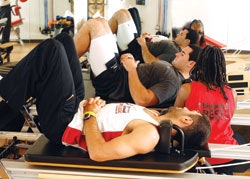Corporate fitness professionals believe in the value of their programs, even if returns are difficult to track.
 IT'S THE NETWORK Verizon Wireless employees can use any of the company's 34 fitness centers located throughout the country.
IT'S THE NETWORK Verizon Wireless employees can use any of the company's 34 fitness centers located throughout the country.Mark Monteyne once worked the customer service lines at a Bell Atlantic call center in Bedminster, N.J. He would escape at noon for a run, then return to his sedentary position to post 60 to 70 calls by day's end. For someone holding a degree in adult fitness, the thought of a long-term career spent mostly sitting did not sit well with Monteyne, who spied a spare room within the facility and approached the company's human resources department about converting the space into a fitness center.
That was 1990. Bell Atlantic Mobile became Verizon Wireless, and that first 500-square-foot room housing one treadmill and one stepper has grown into a nationwide network of in-house fitness centers that - with the opening of one in Little Rock, Ark., this month - will total 34, each one staffed by two full-time wellness coaches. The facilities average 3,500 square feet and include a full complement of strength and cardio equipment, as well as showers. "This gets you away from the ball and chain of your computer," says Monteyne, who remains the program's head coach. "It gives you an opportunity to go to a place, a happy place, within the facility. You come in, you get a great workout and then you have a great rest of the day."
In exchange for membership, individuals agree to have $15 per month deducted from their paycheck, and roughly 13,000 Verizon employees (representing 42 percent of the company) have opted in. "As a member, I can tell you one of the things that I think is terrific is having access to a personal trainer when you need one," says Laura Merritt, public relations manager in Verizon's Dublin, Ohio, location. "When I talk to people outside our company and tell them about access to an expert who can walk me through a plan and get me doing the types of things that are really going to get me the best results, they're always amazed. That's a very cool feature that we offer, and I'm not sure if that's common in these types of facilities."
Trying to find commonality among corporate wellness efforts isn't easy. The landscape ranges from bike racks and walking trails outside businesses to outdoor sports complexes and disc golf courses within industrial parks. There's an auto salvage yard in St. Paul, Minn., that brings in an instructor to lead dozens of men, many of whom spend the bulk of the workday reaching up under elevated chassis, through weekly Pilates sessions - their makeshift exercise mats ripped from car trunks and arranged on the blacktop. The company's owners, who also partake in the mandatory workouts, pay $95 per session in an attempt to curtail $100,000 in annual workers' compensation claims.
While stretching their mechanics and our concept of corporate wellness, the owners of Ace Auto Parts are nonetheless part of a growing trend. According to the Kaiser Family Foundation, about six of every 10 employers offer at least some form of wellness benefit. Some estimates put the number at eight of 10 for companies with at least 50 employees. Corporate Wellness Magazine, in publication only since July 2009, sponsored its second annual Corporate Wellness Conference in September. "Health promotion has been strengthened by media coverage of healthcare reform," says Brenda Loube, principal and co-founder of Corporate Fitness Works, a St. Petersburg, Fla.-based firm has been helping companies design, equip and manage on-site fitness and wellness centers since 1988. "The industry has benefited from the attention that's been given to wellness in general in our country."
But are the employees - and, by extension, the companies - truly benefiting? It's not hard to find anecdotal evidence of pounds shed by individuals or collectively among coworkers. However, it can take years before corporate return on investment is realized, if it's realized at all. Along with such notional concepts as improved employee morale, quantifiable outcomes often cited as program goals include reductions in absenteeism and the company's overall healthcare costs. For the sixth edition of Proof Positive: An Analysis of the Cost-Effectiveness of Wellness, published in 2008, public health expert Larry Chapman analyzed 60 peer-reviewed studies of worksite health promotion programs and found they can be credited for substantial reductions in sick leave (27.8 percent, on average), health costs (28.7 percent), disability (33.5 percent) and workers comp costs (33.5 percent). Moreover, every dollar invested saved $5.50 in related costs, a figure that doesn't surprise Loube. "Whatever study you look at, for every dollar invested in wellness, there's been a $3 to $6 return" in cost savings, she says.
Those kinds of numbers are getting the attention of employers still on the wellness fence, particularly in the current economy. "A lot of businesses are making cost cutbacks," Loube says. "Rising healthcare costs, however, have definitely prompted companies to evaluate their approach to employee wellness, and since physical activity is a key component, many are researching the feasibility of doing on-site fitness programs."
 CABLE COMPANY Among other fitness center amenities, CXtec offers employees access to selectorized strength training equipment.
CABLE COMPANY Among other fitness center amenities, CXtec offers employees access to selectorized strength training equipment.When AB interviewed William Pomeroy in 1997, the founder and owner of Cable Express Technologies (now CXtec), a Syracuse, N.Y.-based computer and telecommunications parts supplier, was just moving into a 66,000-square-foot facility, and had not yet made up his mind whether to dedicate space to an in-house fitness center. He wound up carving out 2,000 square feet and filled it with used and refurbished treadmills, elliptical machines and selectorized strength training equipment, most of which is still in operation and fully depreciated. In addition, large meeting rooms are used for six-week step-aerobics classes and yoga sessions, led twice weekly by hired instructors.
Though the fitness center at CXtec, where 320 employees work, logged a seemingly modest 183 visits in September, Pomeroy voices no regrets about his investment. In fact, he added a second fitness center at CXtec's distribution facility, serving another 40 employees. "We have four seasons here, and particularly in the wintertime it's a bit more difficult to get the kind of exercise you need for proper cardiovascular health. I wanted to make sure that the folks here had that opportunity," says Pomeroy, whose $100 million company is self-insured. "We don't know whether the investment has a hard payback or not. I'll tell you, though, in terms of employee satisfaction it has. A lot of folks have told me when they first join us, 'Gosh, this is going to be great. I don't have to keep paying my health club dues anymore.' You don't have to wear a suit here, and you don't have to belong to a health club."
Deconditioned or sick employees lead to a potential cost that's even harder for individual companies to pin down. But studies indicate that productivity losses due to presenteeism (when workers show up but are not productive) can amount to 60 percent of the total cost of worker illness - exceeding the costs of absenteeism and medical and disability benefits.
The marketplace is filled with health assessment tools that employers can use to gauge, and potentially modify, workers' risk factors and behaviors. Some companies have been doing such assessments for decades, with dramatic results. Johnson & Johnson, producer of Band-Aids and Tylenol, launched its first wellness initiative in 1978, and by 2008 could boast 80 percent participation and an annual reduction in healthcare costs of $400 per employee.
Indeed, conventional wisdom indicates that a comprehensive program involving a wide range of assessment opportunities, activities and incentives, customization to the corporate culture, and buy-in and communication from senior leadership stands the best chance of success. Those were among the key findings in a new study of corporate wellness conducted by the Center for Studying Health System Change (HSC), which interviewed 45 health industry experts and representatives of benefits consulting firms, health plans, wellness companies and employers sponsoring wellness programs. "Many experts told us that employers that lack the ability and commitment to support a comprehensive wellness program may be wiser to stay on the sidelines," says study co-author Ha T. Tu, a senior HSC health researcher.
When asked if offering something is better than nothing, Loube says, "I'm a health professional, so any activity to me is important. We know that the magic pill, if you will, is daily physical activity." That said, Loube recommends gathering ROI data (something that the HSC researchers admit can be difficult and may take several years), or at least participation numbers among eligible populations and testimony in support of programs and facilities - the ongoing existence of which may hinge on such intelligence. But more troubling than a wellness program that dies is one that never got a chance. "To me, prevention is where it's at," Loube says. "It is truly the model we should all be following - versus the sick-care model that many live with today - because we know it works."
Verizon's Monteyne, for one, says he doesn't need to look at numbers to know he started something lasting and good in a tiny room some 20 years ago. "If I have to pull out that file," he says, "it's a sad day."
Today, the Verizon program has expanded to provide nutritional counseling, healthful vending machine options and 60-second online video clips called "Fit By the Minute," which cover everything from quick exercises that employees can perform at their desks to healthful recipes they can make at home. "We truly believe that a healthy employee is a more productive employee," says Monteyne. "It's so ingrained in our culture that we know it's the right thing to do. And the employees love it. They love the one-on-one training, the nutritional counseling, the professional staff - and they see value. From a human-resources standpoint, we say it's the best employee benefit that we offer."





































